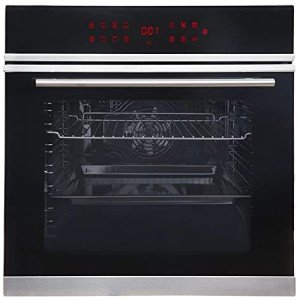Understanding Self-Cleaning Oven Costs: A Comprehensive Guide
In the realm of modern cooking devices, self-cleaning ovens stand apart as an advanced innovation, combining benefit with efficiency. Gone are the days of laboriously scrubbing the oven after a greasy meal. However, key aspirants in buying or utilizing such appliances might find themselves pondering the associated costs. This article explores numerous measurements of self-cleaning oven costs, supplying a comprehensive understanding for customers.
What Is a Self-Cleaning Oven?
A self-cleaning oven automates the process of cleaning the oven's interior using exceptionally high temperature levels (typically around 800 ° F or 427 ° C). This process incinerates food residue and spills into fine ash, making it easier to wipe away. Usually, self-cleaning options come in 2 primary formats: pyrolytic and steam cleaning. Pyrolytic ovens create high heat, while steam cleaning ovens use steam to soften the grime.
The Costs Associated with Self-Cleaning Ovens
Comprehending the costs of self-cleaning ovens involves examining several aspects including purchase rate, operational costs, and prospective repair and maintenance costs. Below is an in-depth breakdown of these elements.
1. Initial Purchase Cost
The preliminary expense of a self-cleaning oven can vary extensively based upon brand name, model, and features.
| Kind of Oven | Cost Range |
|---|---|
| Fundamental Model | ₤ 600 - ₤ 800 |
| Mid-Range Model | ₤ 800 - ₤ 1,200 |
| High-End Model | ₤ 1,200 - ₤ 2,500+ |
2. Functional Costs
Functional costs consist of energies and any additional cleaning products. While self-cleaning ovens decrease the requirement for harsh chemicals, electrical power consumption throughout cleaning need to be considered.
- Electrical power Costs: Running a self-cleaning cycle can consume about 2-3 kWh of electrical energy. Depending upon local rates, this may include around ₤ 0.30 to ₤ 1.00 to the month-to-month costs.
- Cleaning Supplies: While self-cleaning ovens reduce the requirement for cleaners, some users might go with surface area cleaners for preserving the outside or touch-ups.
3. Maintenance and Repair Costs
Though self-cleaning ovens are normally low-maintenance, they might need occasional repairs.
- Regular Maintenance: This may include examining seals, changing light bulbs, or cleaning the door.
- Unforeseen Repairs: Some typical repairs can cost in between ₤ 100-₤ 500 depending upon the problem.
4. Long-Term Value Consideration
Buying a self-cleaning oven can cause long-lasting savings:
- Less Time Spent Cleaning: The time saved during cleaning translates to value, especially for busy families.
- Preserve Efficiency: A clean oven runs more effectively, possibly reducing energy costs gradually.
Frequently Asked Questions Regarding Self-Cleaning Ovens
Q1: Are self-cleaning ovens safe to use?
Yes, self-cleaning ovens are typically safe when utilized according to maker directions. The high temperature levels included can produce smoke or odors, so correct ventilation is recommended.
Q2: How often should I utilize the self-cleaning function?
Usage can vary based on how frequently the oven is used and the types of foods prepared. Self Cleaning Oven Benefits find that a self-cleaning cycle every 3 to 6 months is appropriate.
Q3: Can you use the oven while it's in self-cleaning mode?
No, it is risky to use the oven while it is undergoing the self-cleaning process. Ensure all cooking is done before starting a cleaning cycle.
Q4: What occurs to the oven if there is a lot of buildup?
In cases of extreme buildup, it is recommended to clean away large pieces of debris before starting a self-cleaning cycle. Continuous neglect might result in a greater risk of fire.
Pros and Cons of Self-Cleaning Ovens
Benefits
- Convenience: Automates the cleaning process, conserving time and effort.
- Less Harsh Chemicals: Minimizes the requirement for unpredictable cleaners.
- Thorough Cleaning: High temperatures destroy most residues, making sure tidiness.
Disadvantages
- Higher Initial Costs: The purchase rate is generally greater than basic ovens.
- Energy Consumption: Self-cleaning cycles utilize considerable amounts of electrical energy.
- Possible Wear and Tear: Frequent use may reduce the lifespan of some components.
Self-cleaning ovens represent a substantial advancement in kitchen area benefit, despite their associated costs. When considering buying a self-cleaning oven, it's vital to take into account not just the initial purchase cost, however likewise continuous functional costs, maintenance requirements, and long-term benefits. By weighing these aspects, consumers can make informed choices that align with their cooking routines and spending plan restraints. The convenience afforded by self-cleaning technology continues to make it a favorable option for hectic kitchen areas, proving that often, a little investment in time and resources settles in a substantial leap in convenience and ease.
When it concerns modern-day cooking area devices, self-cleaning ovens offer not just a service to an as soon as problematic chore but likewise improve overall cooking experiences. The sensible prospective buyer must evaluate total costs and benefits before purchasing choice, guaranteeing their investment aligns with their culinary needs.

